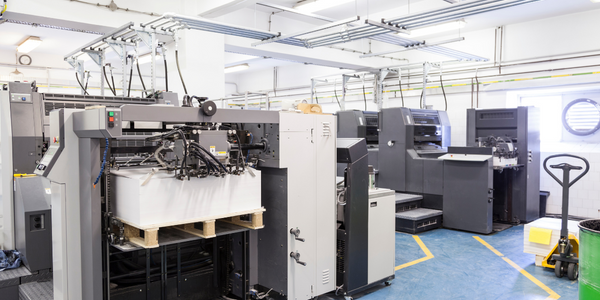
技术
- 分析与建模 - 大数据分析
- 网络与连接 - 网关
- 传感器 - 温度传感器
- 传感器 - 振动传感器
- 传感器 - 电压传感器
适用功能
- 物流运输
用例
- 机器状态监测
客户
未公开
关于客户
一个配送中心
挑战
配送中心使用传送带系统将各种产品运输到适当的位置。当一切顺利时,产品以最小的麻烦被交付、储存和运回。但是运行传送带的任何电机发生故障都可能干扰操作并导致无法接受的运输延误。配送中心决定使用远程监控和决策分析来预测何时何地,预防性维护可以防止小问题膨胀成重大中断。
解决方案
B+B 的一位增值经销商使用 B+B 的 Wzzard 传感器平台和决策分析解决了这个问题。他们在每个电机上放置电流、振动和温度传感器,并将传感器连接到 Wzzard 智能边缘节点。智能边缘节点使用 SmartMesh IP 网状网络向 Spectre 网络网关报告传感器数据,后者可以通过有线或蜂窝网络连接到分析应用程序。整个系统都是无线的,因此无需使用大量新的电缆将配送中心弄得杂乱无章。
收集的数据
Condition Based Monitoring, Engine Temperature, Maintenance Requirements, Shipping Time, Vibration
运营影响

Case Study missing?
Start adding your own!
Register with your work email and create a new case study profile for your business.
相关案例.

Case Study
IoT enabled Fleet Management with MindSphere
In view of growing competition, Gämmerler had a strong need to remain competitive via process optimization, reliability and gentle handling of printed products, even at highest press speeds. In addition, a digitalization initiative also included developing a key differentiation via data-driven services offers.

Case Study
Siemens Wind Power
Wind provides clean, renewable energy. The core concept is simple: wind turbines spin blades to generate power. However, today's systems are anything but simple. Modern wind turbines have blades that sweep a 120 meter circle, cost more than 1 million dollars and generate multiple megawatts of power. Each turbine may include up to 1,000 sensors and actuators – integrating strain gages, bearing monitors and power conditioning technology. The turbine can control blade speed and power generation by altering the blade pitch and power extraction. Controlling the turbine is a sophisticated job requiring many cooperating processors closing high-speed loops and implementing intelligent monitoring and optimization algorithms. But the real challenge is integrating these turbines so that they work together. A wind farm may include hundreds of turbines. They are often installed in difficult-to-access locations at sea. The farm must implement a fundamentally and truly distributed control system. Like all power systems, the goal of the farm is to match generation to load. A farm with hundreds of turbines must optimize that load by balancing the loading and generation across a wide geography. Wind, of course, is dynamic. Almost every picture of a wind farm shows a calm sea and a setting sun. But things get challenging when a storm goes through the wind farm. In a storm, the control system must decide how to take energy out of gusts to generate constant power. It must intelligently balance load across many turbines. And a critical consideration is the loading and potential damage to a half-billion-dollar installed asset. This is no environment for a slow or undependable control system. Reliability and performance are crucial.

Case Study
Integration of PLC with IoT for Bosch Rexroth
The application arises from the need to monitor and anticipate the problems of one or more machines managed by a PLC. These problems, often resulting from the accumulation over time of small discrepancies, require, when they occur, ex post technical operations maintenance.

Case Study
Refinery Saves Over $700,000 with Smart Wireless
One of the largest petroleum refineries in the world is equipped to refine various types of crude oil and manufacture various grades of fuel from motor gasoline to Aviation Turbine Fuel. Due to wear and tear, eight hydrogen valves in each refinery were leaking, and each cost $1800 per ton of hydrogen vented. The plant also had leakage on nearly 30 flare control hydrocarbon valves. The refinery wanted a continuous, online monitoring system that could catch leaks early, minimize hydrogen and hydrocarbon production losses, and improve safety for maintenance.

Case Study
A Cloud-based Machine Performance Assistant
Printing International is building pad printing machinery to print on all kinds of plastics, glass, ceramics, porcelain, on caps and closures, medical devices and pharmaceuticals. 4 Key Project Requirements: • Transparency on machine performance • Worldwide service network • Remote support, contractual availability • IT security

Case Study
Airport SCADA Systems Improve Service Levels
Modern airports are one of the busiest environments on Earth and rely on process automation equipment to ensure service operators achieve their KPIs. Increasingly airport SCADA systems are being used to control all aspects of the operation and associated facilities. This is because unplanned system downtime can cost dearly, both in terms of reduced revenues and the associated loss of customer satisfaction due to inevitable travel inconvenience and disruption.



